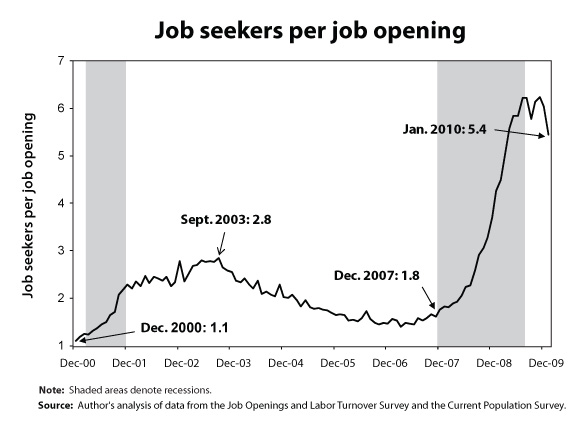This morning, the Bureau of Labor Statistics released the January report from the Job Openings and Labor Turnover Survey (JOLTS), showing that job openings increased by 193,000 to 2.7 million in January (including an upward revision of 34,000 to earlier data). From the Current Population Survey, we know that the number of unemployed workers decreased in January by 430,000 to 14.8 million. This means there was substantial improvement in the ratio of job seekers per job opening, which dropped from 6.0 in December to 5.4 in January (see Figure). As the figure shows, there is a good deal of month-to-month volatility in this ratio, but nevertheless January marked the largest one-month improvement in the history of the series. At 5.4, the number of unemployed workers per job opening is the lowest it has been since March of last year. However, it remains almost twice as high as the worst month of the recession of the early 2000s, when it peaked at 2.8.

After bottoming out at around 2.4 million last summer and remaining fairly stagnant since then, the number of job openings finally appears to be picking up. This is good news, since at 2.7 million job openings in January, there is considerable ground to make up. By comparison, in 2007, there were 4.6 million jobs openings per month on average. To absorb the nearly 15 million officially unemployed workers in this country, plus the roughly 2.6 million “marginally attached” workers (jobless workers who want a job but have given up actively seeking work and are therefore not counted as officially unemployed), job openings and hiring must rebound dramatically. The $15 billion jobs bill passed by the Senate and the House is good in the sense that Congress is now acting on the need for jobs creation, but the effort is far too small. It is likely to create at most a couple hundred thousand jobs, while there are nearly 15 million unemployed workers. Congress needs to act quickly and at a sufficient scale to avoid very high levels of unemployment for the next several years.
For more information on the historical ratio between job seekers and job openings, visit EPI’s Economy Track.